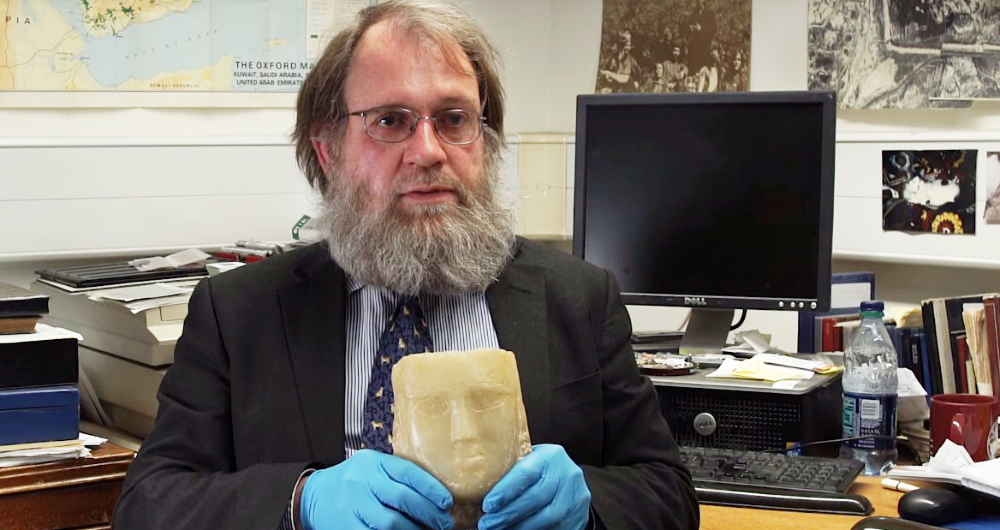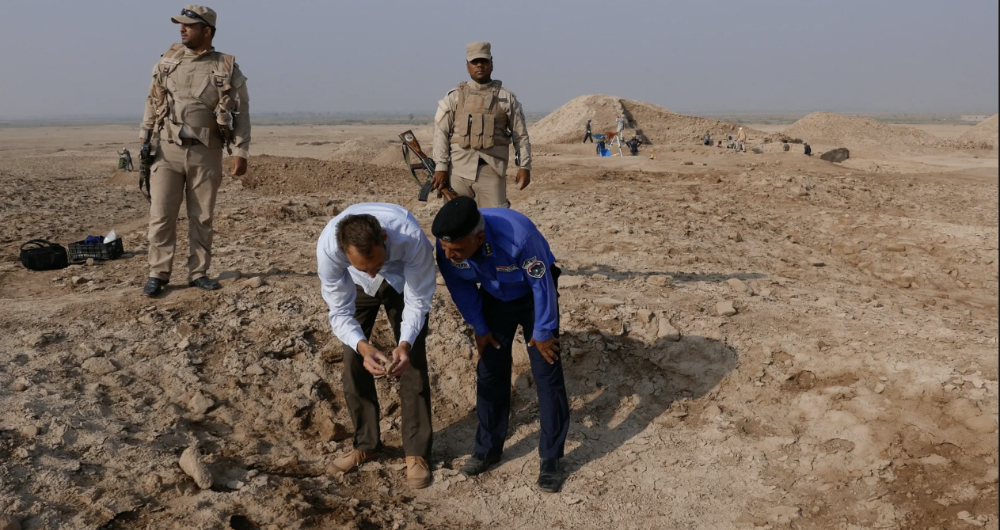LONDON: On July 1 last year, the suspicions of UK Border Force agents were aroused by two metal trunks that arrived at Heathrow Airport on a flight from Bahrain.
Such is the game of cat and mouse played between international customs officials and criminals intent on shipping illegal items through the world’s complex air and shipping networks, that the force flatly refuses to disclose exactly what it was that drew its attention to just two items among the almost 2 million metric tons of cargo that arrives at the airport every year.
Whatever it was, after peeking inside with an X-ray machine, officers opened the trunks and found themselves gazing upon what at first appeared to be a treasure trove of Mesopotamian antiquities, protected by cardboard and bubble wrap.
Most likely looted from archaeological sites in Iraq, they had been dispatched to a private address in the UK.
The lucrative business of supplying unscrupulous private collectors around the world with the looted heritage of the nations that now straddle the lost empires of the ancient world began in earnest in the chaos that followed the 2003 invasion of Iraq.
In recent years, however, thanks to increased stability and security in Iraq and the on-the-ground support of the British Museum and other overseas institutions, the situation has improved.
So much so, in fact, that when experts at the British Museum examined the contents of the two trunks, they discovered that the Border Force had intercepted not stolen artifacts worth tens of thousands of pounds, but a collection of worthless fake antiquities.
The discovery was confirmation, believes archaeologist Dr. St John Simpson, senior curator and assistant keeper of the British Museum’s Middle East Department, that the war on looters is being won.

Dr. St John Simpson, senior curator and assistant keeper of the British Museum’s Middle East Department.
To Dr. Simpson’s expert eye, the items were obviously very bad fakes. “All it took was one look, really,” he said. “It’s far better that there are fakes out there than real trafficked antiquities.”
In August last year 156 cuneiform tablets, stolen in Iraq and smuggled into the UK in 2011, were returned to the country through the British Museum, to which all seized cultural heritage objects are brought for analysis, conservation and cataloguing before they are returned to their rightful national owners.
The tablets, thought to have come from Umma, Larsa and a recently discovered archaeological site called Irisagrig, ranged in date from the Achaemenid period, the sixth to fourth centuries BC, to the mid-third millennium BC.
The documents were mostly economic forms but also included letters, legal and school texts and a mathematical text.
Comparison of these original artifacts with the seized haul of fakes shows what the forgers were aiming for — and how badly they missed their target.
Unlike looting, which deprives an entire nation of its heritage, faking artifacts has only one direct victim — an unscrupulous wealthy individual blessed, perhaps, with rather more money than sense.
“In this case I think it was somebody very gullible indeed,” says Simpson, “probably somebody who is interested in collecting ancient Mesopotamian documents as examples of the first writing in the Middle East, has read about them, maybe seen pictures of them, but has never actually handled the original, and who fell for fraud.”
Among the seized items were 190 fake clay tablets covered in cuneiform script, the early form of writing invented by the Sumerians some 6,000 years ago.

Stability and security in the region has made looting harder. (Supplied)
The forgers had gone to the trouble of mastering the technique of creating the script by pressing a cut-reed or wooden stylus into damp clay — the word cuneiform comes from the Latin word for a wedge.
“It’s actually quite a lot of effort to produce these things,” says Simpson, but it was all in vain. Much of what they had written was “gibberish.”
“In a few cases they have taken phrases off real documents — the opening lines of well-known inscriptions have been copied — but in most cases the wedges are random,” he said.
Many of the inscriptions were an incoherent jumble of signs, some invented, while others were upside-down.
If this had not been enough to give the game away, it was obvious that the clay tablets, quite apart from having been made from the wrong sort of clay, had all been fired to a high temperature in a modern kiln, whereas the real items would have been dried by the heat of the sun.
Even more suspicious, concluded the British Museum, was the fact that “the collection seemed to represent a virtually complete range of basic types known from ancient Mesopotamia.”
It included cushion-shaped school texts designed to be held in one hand and written on one side only; inscribed cylinders designed for burial; administrative texts; a royal inscription referring to the late-Assyrian king, Adadnirari, a mathematical tablet; and an amulet clearly copied from a unique example excavated at the Assyrian capital of Nimrud.
The collection also included iconic clay wall cones, offerings to the gods of the Sumerians bearing dedicatory texts from Mesopotamian rulers.
It was, said the museum, “as if the whole genre of ancient Mesopotamian writing was represented in one shipment: An entire collection ready for a single, uninformed buyer.”
Faking, added Simpson, “is an emerging trend. There is still looting going on in certain parts of the world — in parts of Syria there has been very bad looting. But the supply of fakes is on the increase. We see examples brought to us by law enforcement all of the time, and this applies to mosaics, glass, metal, carved stone sculptures and clay tablets, like these.”

Some of the inscribed clay tablets after unwrapping. (British Museum)
It is, as he wrote in a recent blog for the museum, “easier and cheaper to make copies than it is to hire dozens of workers to look for originals. Fakes can also be conveniently complete, whereas almost everything from antiquity has been broken, either deliberately in episodes of destruction, or accidentally in the case of everyday items. There is also the simple economic truth of the laws of supply and demand.”
Looting in Iraq is now largely under control, said Simpson, who last year visited one site in the south of the country that had been seriously damaged by looters in the wake of the 2003 US-led invasion.
“That was a really bad case of organized looting of an early second millennium BC site, where all the prominent areas of ancient occupation had been dug over, probably by several hundred workmen operating probably at night and in an organized way.”
It was, he said, in effect “a massive crime scene.”
Today, the site, and others like it throughout the country, is well protected by the State Board of Antiquities and Heritage of Iraq.
“There is a very efficient archaeological police that patrols the landscape and works with villagers and tribes to investigate any reports of ad hoc digging, and they have very much shut down the organized looting of sites in Iraq.”
The British Museum has been supporting the country’s efforts to restore its archaeological heritage with its Iraq Emergency Heritage Management Training Scheme.
Funded by the UK government, since 2015 it has trained dozens of archaeologists from across Iraq in the latest techniques in cultural heritage management and practical fieldwork skills.
The seized fakes will now be used for teaching and training purposes and a selection will go on display for a short period at the British Museum when it reopens.
The objects will occupy a special showcase in Room 53, where the museum has previously shown Gandharan sculptures and a temple carving from Surkh Kotal, stolen from the National Museum of Afghanistan – all of which will be going back to Kabul when the lockdown eases.
Two mysteries continue to surround the consignment seized by the UK Border Force. The news about the seizure has emerged only now, almost a year after the discovery, for legal reasons, yet despite extensive investigations no arrests have been made in the UK.
The source of the fakes also remains unknown.
Exactly where the forgers’ workshops are based “is difficult to say at the moment,” said Simpson.
“We believe they are probably somewhere within the Middle East, but we have seen evidence of metalwork purporting to be from Iran or the Islamic world actually being made in the Far East. There is a global market.”













